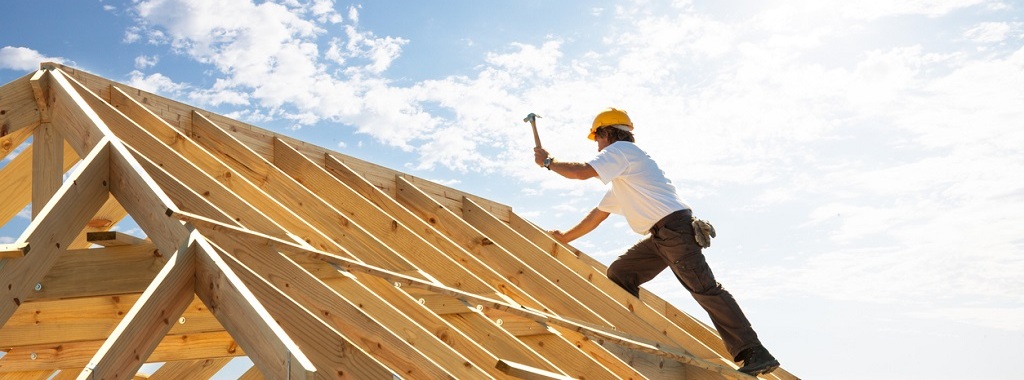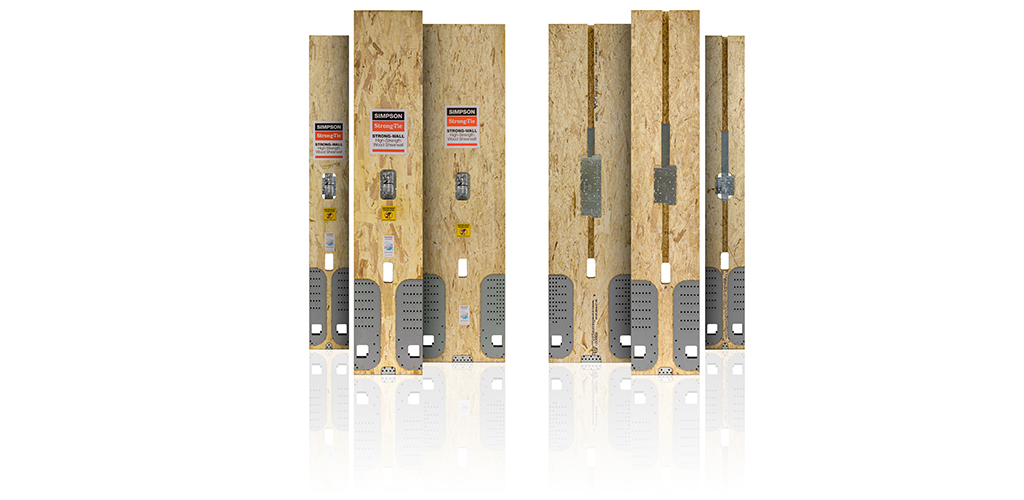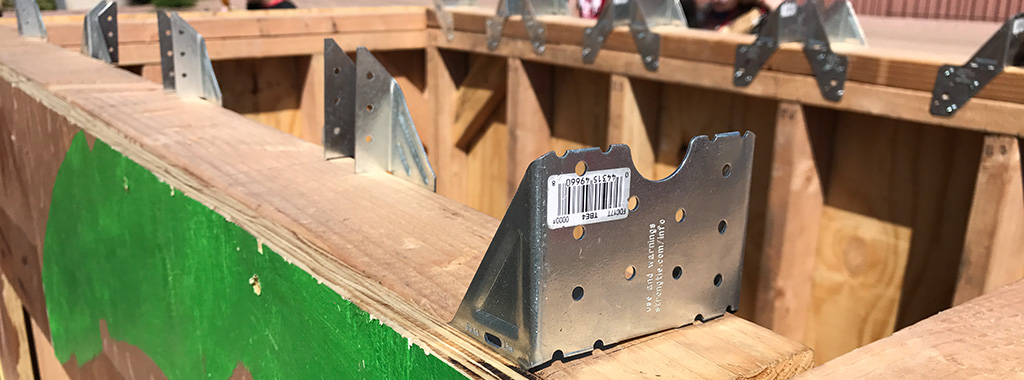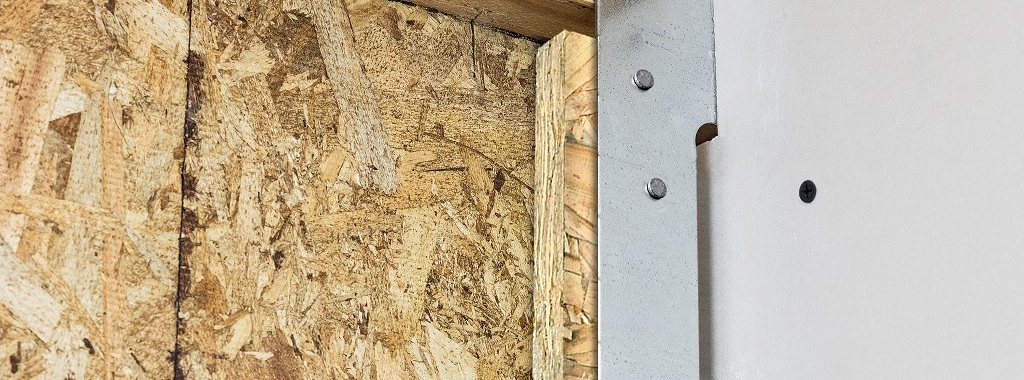In the last post, we described the primary structural and wood-related changes in the 2021 International Residential Code, Chapters 3 and 4. This post will continue with the primary changes to Chapters 5 through 8 of the IRC.
Tag: wood
Questions Answered: Strong-Wall® High-Strength Wood Shearwall Webinar
In this post, we follow up on our July webinar, Innovations in Strength and Versatility: Overview of the Strong-Wall® High-Strength Wood Shearwall, by answering some of the interesting questions raised by attendees. Continue Reading
Timber Strong Gives Engineering Students Real-World Experience
Structural engineering, like every other research field, advances by educating new generations of students in the principles and practice of the discipline. Knowing that, Simpson Strong-Tie has teamed with the Binational Softwood Lumber Council and the American Wood Council to co-sponsor and coordinate the Timber Strong Design-Build Competition, an annual design contest held at the ASCE Pacific Southwest Conference in Tempe, Arizona.
Engineering students will test their civil and environmental engineering skills this spring when they compete in the annual Timber Strong Design-Build Competition. Eighteen universities will send teams of students to Tempe, Arizona, to participate at the American Society of Civil Engineers (ASCE) Pacific Southwest Conference (PSWC).
The objective of the competition, taking place April 12–14, is to give students valuable real-world engineering design experience:
Continue Reading
Fire Protection Considerations with Five-Story Wood-Frame Buildings Part 1
As a regional director for WoodWorks, my job is to provide technical assistance related to the design of nonresidential and multi-family wood buildings. I’ve been with the program since it launched in 2007 and, although we support a full range of building types, I’ve seen a steady increase in the number of design professionals looking for information and support related to mid-rise wood structures in particular.Continue Reading
Deck Fasteners – Deck Board to Framing Attachments
When you’re building a deck, it’s important to know the types of fasteners you need to use with the various materials that are available. On this week’s post we explore some deck fastener applications as well as offer suggestions on how to avoid a few common problems. We will address two generic types of deck boards fastened to wood framing: preservative-treated wood and composite decking.
Preservative-Treated Wood Decking
With preservative treated wood, it pays to know the board treatment. Wood is treated with a water-borne treatment chemical (typically micronized copper azole these days) and then it is either sent out wet or it is kiln dried. Wet-treated wood can have a moisture content (MC) greater than 30%. Wood that is subsequently kiln dried to remove excess moisture after the treatment process is labeled Kiln-Dried After Treatment (KDAT) and has a MC of about 15%. Wood deck boards with preservative treatments will be labeled as such regardless of their moisture condition.
The moisture condition of the deck boards determines how best to fasten and space your deck boards. Wet wood will shrink in width and thickness after installation. As a result, you should install these boards butted tight so that gaps will emerge after they dry in place. On the other hand, KDAT wood or wood that is dry should be installed with 1/8” gaps between boards so there is a slight gap after the boards get wet and swell due to rain, ice and snow. Some manufacturers suggest using an 8d common nail for spacing when installing KDAT decking, as seen in the figure below.
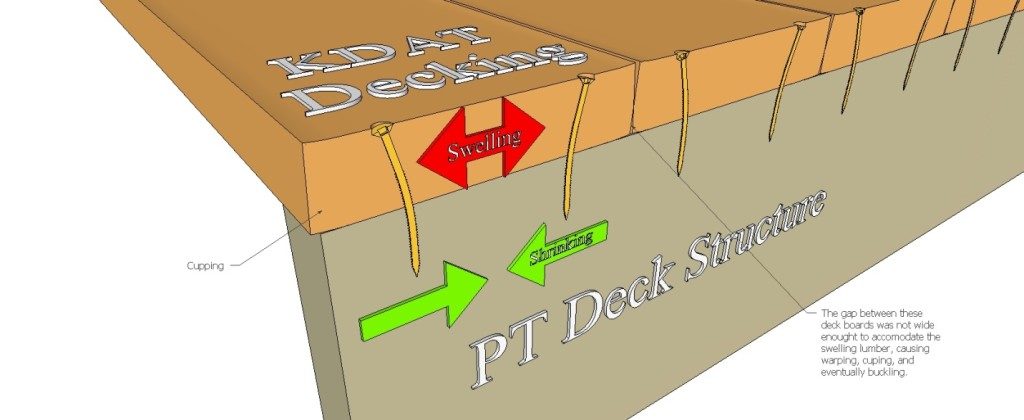
Shrinking and swelling of any installed deck board can cause the deck fastener to bend back and forth with the MC cycling. This causes many deck fasteners to break because of the fatigue loading, which can be exacerbated by the brittle steel used in most deck screws.
To combat this problem, Simpson Strong-Tie developed the DSV Wood screw. This screw is specifically designed with increased ductility to handle the bending induced by deck board movement. It is available in a variety of lengths with threads optimized to prevent jacking between the deck board and the framing, ensuring a snug long-lasting connection.
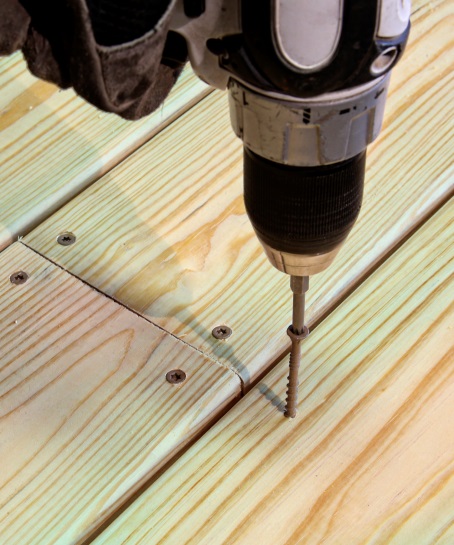
Composite deck boards are made from a mixture of wood fiber and plastic or are entirely “plastic.” Wood plastic composites and plastic materials exhibit thermal expansion, so they expand and contract in thickness, width and length as a function of temperature and solar heating. Consequently, they typically require a special screw designed for composite decking. Screws for this application will often utilize a two-thread design. The lower thread drives the screw into the framing while the upper thread pulls the loosened composite material back into the hole and holds the deck board tight to the joist. Composite screws also have a cap-style head that covers any residual material left around the screw body and leaves a clean finish. Ductility is important to these screws too.
Given the wide variety of composite deck producers, we designed a screw that works well with all of them. The DCU screw works in all types of composite decking fastened to wood framing.
A note about cellular PVC deck boards: the manufacturers’ recommendation of stainless-steel screws restricts the use of many deck board fasteners. Be sure to read and follow the decking material fastener requirements. Simpson Strong-Tie has a broad offering of painted stainless-steel deck screws available to match PVC deck boards. Find the proper match for your board here.
For other deck fastener applications, including decking fastened to steel framing, and information about other deck fasteners available, see our website product page.
Are there other applications that you want to know about that we didn’t share here? Let us know in the comments below. As always, call us in the Engineering Department if you have questions.
Wood-framed Deck Design Resources for Engineers
This week’s blog was written by David Finkenbinder, P.E., who is a regional engineer working out of the Simpson Strong-Tie Ohio branch which services 24 states through the Northeast, Midwest, and Mid-Atlantic. He graduated from Penn State with a B.S. in Agricultural and Biological Engineering in 2004 and earned his M.S. in Civil Engineering with a focus on Structural Engineering from Virginia Tech in 2007. His master’s thesis investigated the splitting strength of bolted connections in solid-sawn lumber and structural composite lumber. Since joining Simpson Strong-Tie in 2007, David has shown a passion for deck safety and has served on committees developing prescriptive information and building code provisions for decks. Here is David’s post.
“Decks cause more injuries and loss of life than any other part of the home structure. Except for hurricanes and tornadoes, more injuries may be connected to deck failures than all other wood building components and loading cases combined.”
This quote, taken from Washington State University’s magazine article Making Decks Safer, underscores the critical importance of proper deck design, construction, and maintenance. An engineer who is encountering their first deck may be surprised that the deck design resources available are not as plentiful as he/she might have expected. The following resources can be helpful start:
For decks built to the IRC, the book Deck Construction Based on the 2009 International Residential Code provides a review of applicable code provisions and related commentary. The book gives background on important durability considerations such as flashing at points where the deck connects to an adjacent structure. The book also briefly discusses variations with IBC provisions, which can be significant for examples such as minimum guard height and live loads.
The American Wood Council (AWC) has several tools available in addition to using the NDS for wood member and connection design. Calculators for evaluating simple span joists and single fastener connections are available in both web-based and mobile app format. Technical Report 12, which was the topic of our May blog post, provides the ability to design connections with a gap between members, or with members having a hollow cross section. AWC’s DCA6 – Prescriptive Residential Wood Deck Construction Guide presents information for common deck details and a commentary covering important considerations for alternate designs. While the guide is helpful, please note that it is limited in scope to single level residential decks and does not address wind or seismic design.
Researchers at Virginia Tech and Washington State University conducted laboratory testing and published information to help in several common topics needing attention. An article in the May 2008 issue of Structure Magazine featured test performance of ledger-to-band joist connections using bolts or lag screws – this information has since been adopted into the IRC.
For lateral design there has been some uncertainty regarding lateral loads that can be generated by occupants, and if the magnitude of such is significant in comparison with wind and seismic forces calculated from ASCE 7. Tests were conducted of occupants performing several types of movement on a deck floor configuration. Separate articles summarizing results for each load type were published in the Summer 2013 issue of Wood Design Focus, along with a fourth article on the lateral performance of IRC ledger attachments (online copies of the articles courtesy of Professional Deck Builder magazine: Wind Loads; Seismic Loads; Occupant Loads).
Our January 2013 post, Corrosion: The Issues, Code Requirements, Research, and Solutions, touches on the corrosion considerations that are significant for most projects as well.
Have you found any other resources that have been helpful in your designs? Let us know by posting a comment.

